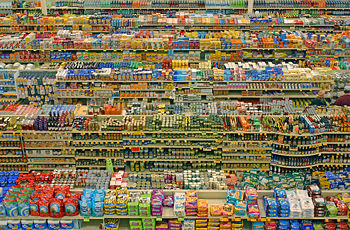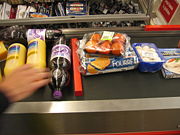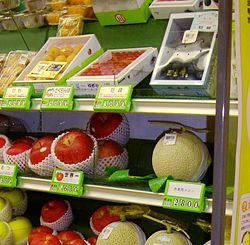Supermarket



A supermarket is a self-service store offering a wide variety of food and household merchandise, organized into departments. It is larger in size and has a wider selection than a traditional grocery store and it is smaller than a hypermarket or superstore.
The supermarket typically comprises meat, fresh produce, dairy, and baked goods departments along with shelf space reserved for canned and packaged goods as well as for various nonfood items such as household cleaners, pharmacy products, and pet supplies. Most supermarkets also sell a variety of other household products that are consumed regularly, such as alcohol (where permitted), household cleaning products, medicine, clothes, and some sell a much wider range of nonfood products.
The traditional suburban supermarket occupies a large amount of floor space, usually on a single level, and is situated near a residential area in order to be convenient to consumers. Its basic appeal is the availability of a broad selection of goods under a single roof at relatively low prices. Other advantages include ease of parking and, frequently, the convenience of shopping hours that extend far into the evening or even 24 hours a day. Supermarkets usually make massive outlays of newspaper and other advertising and often present elaborate in-store displays of products. The stores often are part of a corporate chain that owns or controls (sometimes by franchise) other supermarkets located nearby — even transnationally — thus increasing opportunities for economies of scale.
In North America, supermarkets typically are supplied by the distribution centers of its parent company, such as Loblaw Companies in Canada, which operates thousands of supermarkets across the nation. Loblaw operates a distribution center in every province — usually in the largest city in the province.
Supermarkets usually offer products at low prices by reducing their economic margins. Certain products (typically staple foods such as bread, milk and sugar) are occasionally sold as loss leaders, that is, with negative profit margins. To maintain a profit, supermarkets attempt to make up for the lower margins by a higher overall volume of sales, and with the sale of higher-margin items. Customers usually shop by placing their selected merchandise into shopping carts (trolleys) or baskets (self-service) and pay for the merchandise at the check-out. At present, many supermarket chains are attempting to further reduce labor costs by shifting to self-service check-out machines, where a single employee can oversee a group of four or five machines at once, assisting multiple customers at a time.
A larger full-service supermarket combined with a department store is sometimes known as a hypermarket. Other services offered at some supermarkets may include those of banks, cafés, childcare centers/creches, photo processing, video rentals, pharmacies, and/or gas stations.
Supermarkets use stock rotation, the practice of moving products with an earlier sell-by date to the front of a shelf so they get picked up and sold first.
Contents |
History
In the early days of retailing, all products generally were fetched by an assistant from shelves behind the merchant's counter while customers waited in front of the counter and indicated the items they wanted. Also, most foods and merchandise did not come in the individually wrapped consumer-size packages that we take for granted today, so an assistant had to measure out and wrap the precise amount desired by the consumer. These practices were by nature very labor-intensive and therefore also quite expensive. The shopping process was slow, as the number of customers who could be attended to at one time was limited by the number of clerks employed in the store.
The concept of a self-service grocery store was developed by American entrepreneur Clarence Saunders and his Piggly Wiggly stores. His first store opened in Memphis, Tennessee, in 1916. Saunders was awarded a number of patents for the ideas he incorporated into his stores[1][2][3][4]. The stores were a financial success and Saunders began to offer franchises. The Great Atlantic and Pacific Tea Company (A&P) was another successful early grocery store chain in Canada and the United States, and became common in North American cities in the 1920s. The general trend in retail since then has been to stock shelves at night so that customers, the following day, can obtain their own goods and bring them to the front of the store to pay for them. Although there is a higher risk of shoplifting, the costs of appropriate security measures ideally will be outweighed by the increased economies of scale and reduced labor costs.
Early self-service grocery stores did not sell fresh meats or produce. Combination stores that sold perishable items were developed in the 1920s.[5]
According to the Smithsonian Institution, the first true supermarket in the United States was opened by a former Kroger employee, Michael J. Cullen, on August 4, 1930, inside a 6,000 square foot (560 m²) former garage in Jamaica, Queens in New York City.[6] The store, King Kullen, (inspired by the fictional character King Kong), operated under the slogan "Pile it high. Sell it low." At the time of Cullen's death in 1941, there were seventeen King Kullen stores in operation.
Other established American grocery chains in the 1930s, such as Kroger and Safeway, at first resisted Cullen's idea, but eventually were forced to build their own supermarkets as the economy sank into the Great Depression and consumers became price-sensitive at a level never experienced before.[7] Kroger took the idea one step further and pioneered the first supermarket surrounded on all four sides by a parking lot.
Supermarkets proliferated across Canada and the United States with the growth of suburban development after World War II. Most North American supermarkets are located in suburban strip malls as an anchor store along with other, smaller retailers. They are generally regional rather than national in their company branding. Kroger is perhaps the most nationally oriented supermarket chain in the United States but it has preserved most of its regional brands, including Ralphs, City Market and King Soopers.
In Canada the largest such chain is Loblaw, which operates stores under a variety of regional names, including Fortinos, Zehrs and the largest Loblaws (named after the company itself). Sobeys is Canada's second largest supermarket with locations across the country, operating under many banners (Sobeys IGA in Quebec). Today, supermarkets are found around the world in dozens of countries.
In the 1950s supermarkets frequently issued trading stamps as incentives to customers. Today, most chains issue store-specific "membership cards," "club cards," or "loyalty cards". These typically enable the card holder to receive special members-only discounts on certain items when the credit card-like device is scanned at check-out.
Traditional supermarkets in many countries face intense competition from discount retailers such as Wal-Mart, Asda in the UK, and Zellers in Canada, which typically are non-union and operate with better buying power. Other competition exists from warehouse clubs such as Costco that offer savings to customers buying in bulk quantities. Superstores, such as those operated by Wal-Mart and Asda, often offer a wide range of goods and services in addition to foods. The proliferation of such warehouse and superstores has contributed to the continuing disappearance of smaller, local grocery stores, increased dependence on the automobile, suburban sprawl because of the necessity for large floorplates, and increased vehicular traffic and air pollution. Some critics consider the chains' common practice of selling loss leaders to be anti-competitive. They are also wary of the negotiating power that large, often multinational, retailers have with suppliers around the world.
Typical supermarket merchandise
Larger supermarkets in North America and Western Europe typically sell a great number of items among many brands, sizes and varieties, including:
- Alcoholic beverages (as state/provincial and/or local laws allow)
- Baby foods and baby-care products such as disposable diapers
- Breads and bakery products (many stores may have a bakery on site that offers specialty and dessert items)
- Books, newspapers, and magazines, including supermarket tabloids
- Bulk dried foods such as legumes, flour, rice, etc. (typically available for self-service)
- Canned goods and dried cereals
- Car-care products (motor oil, cleaners, waxes)
- CDs, DVDs, and videos (including video rentals)
- Cigarettes and other tobacco products
- Clothing and footwear (typically a general, limited assortment)
- Confections and candies
- Cosmetics
- Dairy products and eggs
- Delicatessen foods (ready-to-eat)
- Diet foods
- Electrical products such as light bulbs, extension cords, etc.
- Feminine hygiene products
- Financial services and products such as mortgages, credit cards, savings accounts, wire transfers, etc. (typically offered in-store by a partnering bank or other financial institution)
- Flowers
- Frozen foods and crushed ice
- Fresh produce, fruits and vegetables
- Greeting cards
- Housecleaning products
- Housewares, crockery and cooking utensils, etc. (typically limited)
- Laundry products such as detergents, fabric softeners, etc.
- Lottery tickets (where operational and legal)
- Luggage items (typically limited)
- Meats, fish and seafoods (some stores may offer live fish and seafood items from aquarium tanks)
- Medicines and first aid items (primarily over-the-counter drugs, although many supermarkets also have an on-site pharmacy)
- Nonalcoholic beverages such as soft drinks, juices, bottled water, etc. (some stores may have a juice bar that prepares ready-to-drink freshly squeezed juices, smoothies, etc.)
- Personal hygiene and grooming products
- Pet foods and products
- Seasonal items and decorations
- Snack foods
- Tea and Coffee (some stores may have a commercial-style grinder, typically available for self-service, and/or a staffed coffee bar that prepares ready-to-drink coffee and tea beverages)
- Toys and novelties
In some countries, the range of supermarket merchandise is more strictly focused on food products, although the range of goods for sale is expanding in many locations as typical store sizes continue to increase globally.
Typical store architecture

Most supermarkets are similar in design and layout due to trends in marketing. Fresh produce tends to be located near the entrance of the store. Milk, bread, and other essential staple items are usually situated toward the rear of the store and in other out-of-the-way places, purposely done to maximize the customer's time spent in the store, strolling past other items and capitalizing on impulse buying. The front of the store, or "front end'" is the area where point of sale machines or cash registers are usually located. Many retailers also have implemented self-checkout devices in an attempt to reduce labor costs.
Criticisms
- British author Joanna Blythman is a prominent critic of the modern supermarket.
- In Hong Kong, larger supermarkets (usually called superstores) are criticized for selling the fresh foods traditionally available in local wet markets, making the survival of the smaller family-run wet markets increasingly difficult .
- Supermarkets, in general, also tend to narrow the choices of fruits and vegetables by stocking only varieties with long storage lives, thus leading to medium-term extinction of the cultivation of other varieties.
- In the United States, major-brand supermarkets often demand slotting fees from suppliers in exchange for premium shelf space and/or better positioning (such as at eye-level, on the checkout aisle or at a shelf's "end cap"). This extra supplier cost (up to $30,000 per brand for a chain for each individual SKU) may be reflected in the cost of the products offered. Some critics have questioned the ethical and legal propriety of slotting fee payments and their effect on smaller suppliers [1] [2] [3].
- In The United Kingdom Supermarkets are known to squeeze prices to farmers, force small shops out of business and often favour imports over British produce. [4]
References
- ↑ http://www.google.com/patents?id=UnZhAAAAEBAJ&dq=Clarence+Saunders
- ↑ http://www.google.com/patents?id=dPdNAAAAEBAJ
- ↑ http://www.google.com/patents?id=HjBBAAAAEBAJ&dq=Clarence+Saunders
- ↑ http://www.google.com/patents?id=2dd5AAAAEBAJ&dq=Clarence+Saunders
- ↑ Strasser, Susan Never Done: A History of American Housework Holt Paperbacks, 2000.
- ↑ Anonymous, "The place where supermarketing was born," Mass Market Retailers 19, no. 9 (17 June 2002): 172.
- ↑ Ryan Mathews, "1926-1936: entrepreneurs and enterprise: a look at industry pioneers like King Kullen and J. Frank Grimes, and the institution they created (Special Report: Social Change & the Supermarket)," Progressive Grocer 75, no. 12 (December 1996): 39-43.
See also
- Fast moving consumer goods
- List of supermarket chains
Further reading
- Henry Petroski, Shopping By Design: Supermarkets, like other inventions, didn't just happen; they were designed, developed—and patented., American Scientist Volume: 93 Number: 6 Page: 491[5].
- William Greer, America the Bountiful: How the supermarket came to main street, Food Marketing Institute, 1986. ISBN 999925568X OCLC 14357784
External links
- Food Stories — Explore a century of revolutionary change in UK food culture on the British Library's Food Stories website
- groceteria.com - supermarket history and architecture from the 1920s to the 1970s
- Scrambling for customers, 4 August 2005, San Francisco Chronicle
- Supermarket background and history
- Supermarket News - Nationally circulated weekly trade magazine for the food distribution industry.
- Worldwide Online Supermarket - World's largest online supermarket.
